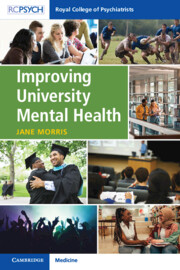Book contents
- Improving University Mental Health
- Improving University Mental Health
- Copyright page
- Contents
- Foreword
- Acknowledgements and Thanks to Contributors
- Chapter 1 Introducing This Handbook
- Chapter 2 Building a New Sense of Belonging
- Chapter 3 The Transition to University for New Students with Pre-Existing Mental Conditions
- Chapter 4 The Roles of Parents and Carers
- Chapter 5 Healthy Bodies, Body Image Concerns, Eating Disorders
- Chapter 6 Alcohol
- Chapter 7 Substance Misuse
- Chapter 8 Social (and Anti-social) Media
- Chapter 9 Finance and Mental Health
- Chapter 10 Neurodiversity
- Chapter 11 Ethnically Diverse University Communities
- Chapter 12 Sexual Behaviour and Gender Identity in Universities
- Chapter 13 The Mental Health of Teaching and Academic Staff
- Chapter 14 An Overview of Mental Disorders in Students and Staff
- Chapter 15 ‘Psychotic’ Disorders
- Chapter 16 Mood Disorders
- Chapter 17 Suicide at University
- Chapter 18 Mental Health Services on Campus and in the NHS
- Chapter 19 Students of the Professions and ‘Fitness to Practise’ Issues
- Chapter 20 Summing It All Up
- Index
- References
Chapter 12 - Sexual Behaviour and Gender Identity in Universities
Published online by Cambridge University Press: 08 February 2024
- Improving University Mental Health
- Improving University Mental Health
- Copyright page
- Contents
- Foreword
- Acknowledgements and Thanks to Contributors
- Chapter 1 Introducing This Handbook
- Chapter 2 Building a New Sense of Belonging
- Chapter 3 The Transition to University for New Students with Pre-Existing Mental Conditions
- Chapter 4 The Roles of Parents and Carers
- Chapter 5 Healthy Bodies, Body Image Concerns, Eating Disorders
- Chapter 6 Alcohol
- Chapter 7 Substance Misuse
- Chapter 8 Social (and Anti-social) Media
- Chapter 9 Finance and Mental Health
- Chapter 10 Neurodiversity
- Chapter 11 Ethnically Diverse University Communities
- Chapter 12 Sexual Behaviour and Gender Identity in Universities
- Chapter 13 The Mental Health of Teaching and Academic Staff
- Chapter 14 An Overview of Mental Disorders in Students and Staff
- Chapter 15 ‘Psychotic’ Disorders
- Chapter 16 Mood Disorders
- Chapter 17 Suicide at University
- Chapter 18 Mental Health Services on Campus and in the NHS
- Chapter 19 Students of the Professions and ‘Fitness to Practise’ Issues
- Chapter 20 Summing It All Up
- Index
- References
Summary
UK university life lends itself to experimentation in sexual behaviour, orientation and gender identity. The experience of sexual liberation can affect trust and communication with students’ culture and family of origin. Casual sexual encounters (‘hooking up’) are common at first. Those who settle into more monogamous ‘dating’ enjoy better mental health. Mental illness is associated with less healthy sexual experiences. The sexual dimension of life is important to the student age group and should be considered in assessment and treatment. Despite the relatively tolerant environment, university LGBTQ+ communities are at higher risk of mental illness. Students with ASD may also need extra support to negotiate sexual development. Some students have previous sexual trauma, which may still be unaddressed. Some school sex education protects students from gender-based violence throughout university, but classes are often delivered without awareness of pupils’ ethical and relational concerns. Social media provides influential, but often misleading sex education. High reliance on online dating is associated with poorer levels of mental health. Excessive alcohol and drug consumption are strongly associated with both perpetrating gender-based violence and becoming a victim.
Keywords
- Type
- Chapter
- Information
- Improving University Mental Health , pp. 178 - 196Publisher: Cambridge University PressPrint publication year: 2024



